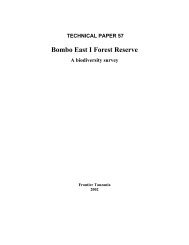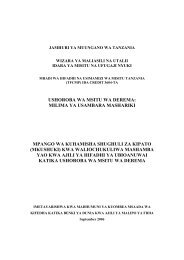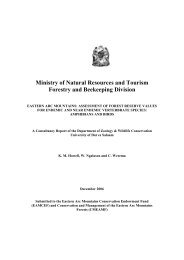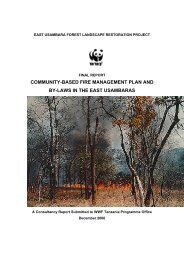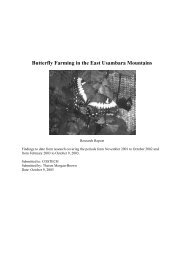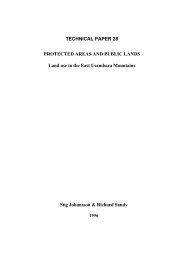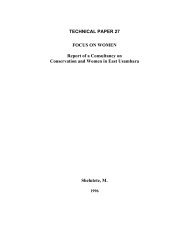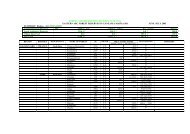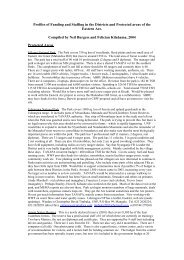Mgambo Forest Reserve: A biodiversity survey. - Eastern Arc ...
Mgambo Forest Reserve: A biodiversity survey. - Eastern Arc ...
Mgambo Forest Reserve: A biodiversity survey. - Eastern Arc ...
You also want an ePaper? Increase the reach of your titles
YUMPU automatically turns print PDFs into web optimized ePapers that Google loves.
<strong>Mgambo</strong> <strong>Forest</strong> <strong>Reserve</strong><br />
KEY TO ABBREVIATIONS FOR TABLE 28<br />
Ecological (Ecol.) type:<br />
F – <strong>Forest</strong> dependent species: Species confined to primary forest only; not including forest edge or secondary forest.<br />
f – <strong>Forest</strong> dwelling but not forest dependent species: Species occurring in primary forest, forest edge or secondary forest.<br />
O – Non-forest species: Species that do not occur in primary or secondary forest or forest edge.<br />
Endemic (End.) status:<br />
E – Endemic: Species only found in the Usambara Mountains.<br />
N – Near endemic: Species with limited ranges usually only including coastal forest and/or East African lowland forests.<br />
W – Widely distributed species.<br />
IUCN status: CITES listings:<br />
EN – Endangered I – Appendix One listed species<br />
VU – Vulnerable II – Appendix Two listed species<br />
LR/NT – Lower Risk/Near Threatened (Appendix Three species not included in Table)<br />
DD – Data Deficient<br />
Appendix 9 summarises reptile trapping data, 35% of individuals were captured opportunistically.<br />
Ecological type, endemic status and threat status were compiled from the National Biodiversity<br />
Database (UDSM, 1997), IUCN (Hilton-Taylor, 2000) and Spawls et al (2002).<br />
Two species captured were categorised as forest dependent, Holaspis guentheri laevis (Speke’s<br />
Sand Lizard) and Cnemaspis africana (Usambara forest gecko) with one near endemic,<br />
Rhamploleon k. kerstenii (Kenyan pygymy chameleon). None were listed as vulnerable or<br />
endangered (IUCN 2000).<br />
Five additional species were recorded in <strong>Mgambo</strong> FR as observations. These are listed in Table<br />
29. An ‘identification confidence’ column has been presented to clarify the reliability of each<br />
sighting. Identification is ranked as follows: Certain, Near Certain, Probable, Possible.<br />
Table 29 Summary of reptile observations in <strong>Mgambo</strong> FR.<br />
Species Common Name Ecol.<br />
type<br />
COLUBRIDAE<br />
Philothamnus<br />
battersbyi<br />
End.<br />
status<br />
IUCN<br />
2000<br />
Threat Status<br />
UDSM<br />
1997<br />
East Usambara Conservation Area Management Programme Technical Paper 59<br />
CITES<br />
2001<br />
58<br />
Identification<br />
confidence<br />
Battersby Green Snake O W Probable<br />
Thelotornis capensis Vine Snake O W Certain<br />
GEKKONIDAE<br />
Lygodactylus<br />
lutecpicturatus<br />
Yellow-headed Dwarf<br />
Gecko<br />
O N LR Certain<br />
TESTUDINIDAE<br />
Kinixys belliana Bell’s Hinged Tortoise O W II Certain<br />
VARANIDAE<br />
Varanus niloticus Nile Monitor Lizard O W II Certain<br />
KEY TO ABBREVIATIONS FOR TABLE 29<br />
Ecological (Ecol.) type:<br />
F – <strong>Forest</strong> dependent species: Species confined to primary forest only; not including forest edge or secondary forest.<br />
f – <strong>Forest</strong> dwelling but not forest dependent species: Species occurring in primary forest, forest edge or secondary forest.<br />
O – Non-forest species: Species that do not occur in primary or secondary forest or forest edge.<br />
Endemic (End.) status:<br />
E – Endemic: Species only found in the Usambara Mountains.<br />
N – Near endemic: Species with limited ranges usually only including coastal forest and/or East African lowland forests.<br />
W – Widely distributed species.<br />
IUCN status: CITES listings:<br />
EN – Endangered I – Appendix One listed species<br />
VU – Vulnerable II – Appendix Two listed species<br />
LR/NT – Lower Risk/Near Threatened (Appendix Three species not included in Table)<br />
DD – Data Deficient



